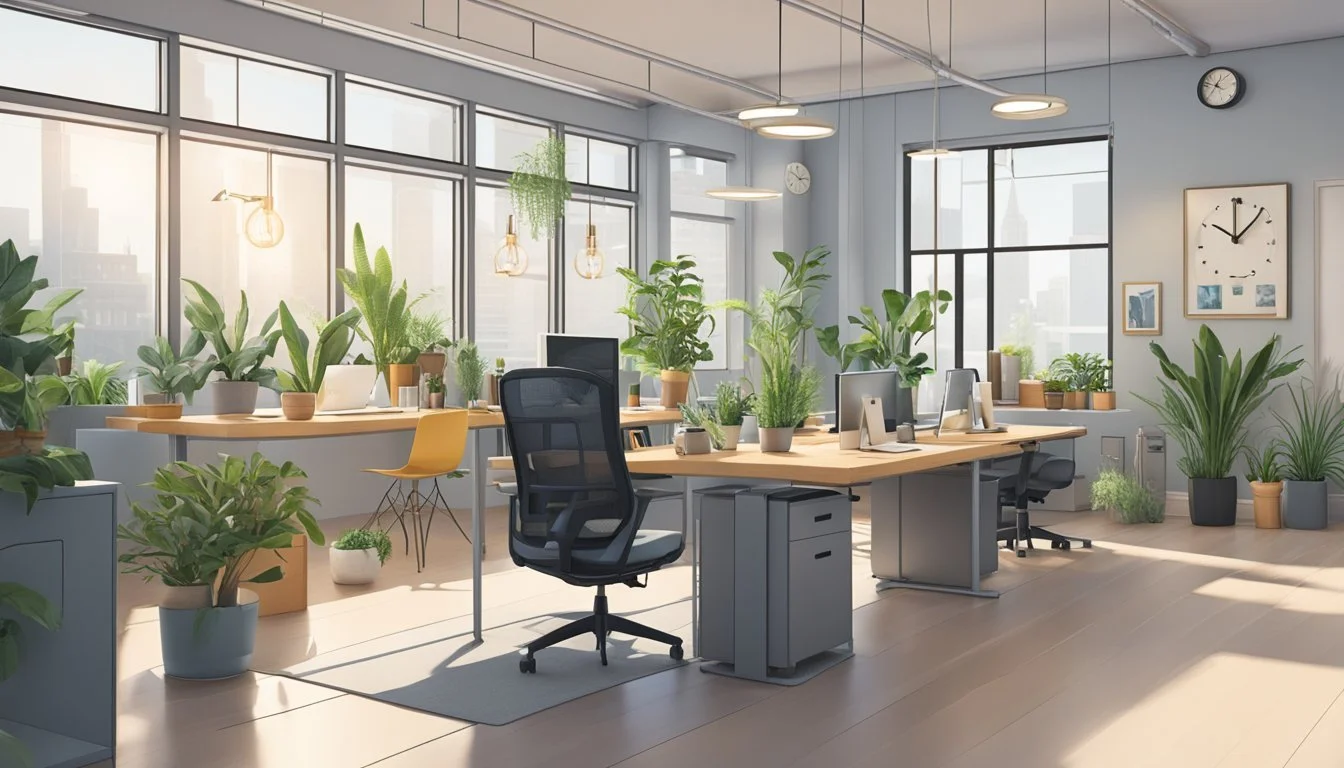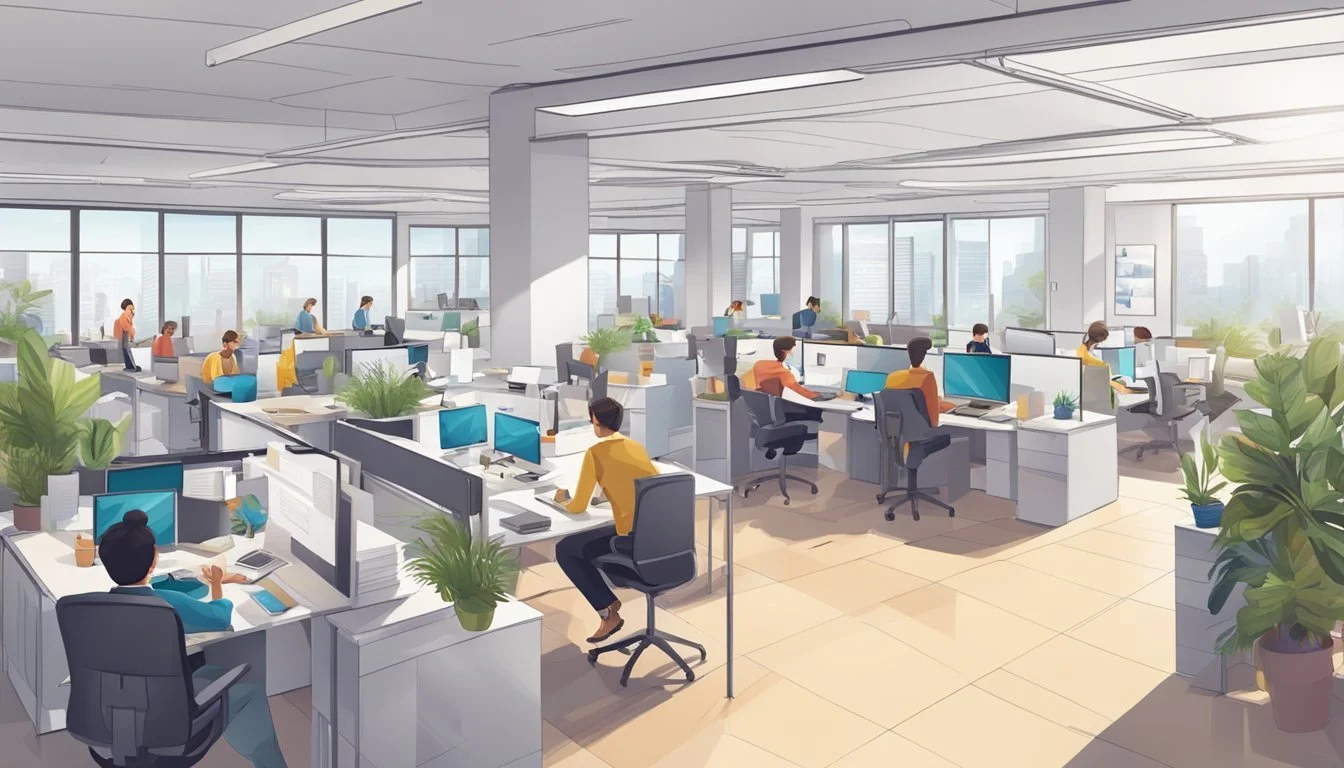Thriving in Shared Workspaces Despite Anxiety Challenges
Open-plan offices have become increasingly common in modern workplaces, offering benefits like improved collaboration and cost-efficiency. However, these environments can also present challenges for employees, particularly those prone to anxiety. The constant noise, visual distractions, and lack of privacy in open spaces can take a toll on mental well-being and productivity.
Implementing effective strategies to manage anxiety in open-plan offices is crucial for maintaining focus, reducing stress, and thriving in this type of work environment. By adopting practical techniques and making thoughtful adjustments, employees can create a more comfortable and productive experience within shared workspaces. This article explores eight approaches to help individuals cope with and minimize anxiety while working in open-plan office settings.
1) Utilize noise-canceling headphones
Noise-canceling headphones are a valuable tool for managing anxiety in open-plan offices. These devices effectively reduce ambient noise, creating a more peaceful work environment.
By blocking out distracting sounds, employees can focus better on their tasks and experience less stress. Many modern noise-canceling headphones offer adjustable levels of noise reduction, allowing users to customize their experience.
Some models even provide the option to play white noise or calming sounds, further enhancing relaxation. Wearing headphones can also serve as a visual cue to colleagues, signaling that the user is concentrating and prefers not to be disturbed.
For optimal comfort during extended use, it's important to choose headphones with a comfortable fit and adequate padding. Over-ear models often provide better noise isolation compared to in-ear options.
When selecting noise-canceling headphones, consider factors such as battery life, wireless capabilities, and compatibility with work devices. Investing in a high-quality pair can significantly improve the work experience in open-plan offices.
2) Create designated quiet areas
Open-plan offices can benefit from dedicated quiet zones. These areas provide a retreat for employees who need to focus on complex tasks or make important phone calls.
Quiet areas should be clearly marked and separate from the main workspace. They can be small rooms, partitioned sections, or simply designated areas with soundproofing elements.
Furnish these spaces with comfortable seating and adequate lighting. Consider adding plants or calming artwork to create a peaceful atmosphere.
Establish clear guidelines for using quiet areas. Encourage employees to respect the purpose of these spaces by maintaining silence and minimizing distractions.
Implement a booking system if necessary to ensure fair access to quiet areas. This can help manage demand and prevent conflicts over usage.
Regular maintenance of quiet areas is essential. Keep them clean, well-ventilated, and equipped with necessary resources like power outlets and Wi-Fi.
By providing designated quiet areas, companies can support employee well-being and productivity in open-plan offices. These spaces offer a valuable option for those who need temporary relief from the bustle of shared workspaces.
3) Encourage flexible working hours
Flexible working hours can significantly reduce anxiety in open-plan offices. This approach allows employees to choose when they start and finish their workday within certain parameters.
By implementing flexible hours, companies empower staff to work during their most productive times. Some individuals perform better in the morning, while others excel later in the day.
Flexible schedules enable employees to avoid peak commute times, reducing stress associated with traffic or crowded public transportation. This can lead to a more relaxed start to the workday.
Allowing flexibility also demonstrates trust in employees, which can boost morale and job satisfaction. When workers feel respected and valued, their anxiety levels often decrease.
Flexible hours can help employees better manage personal responsibilities, such as childcare or medical appointments. This improved work-life balance often leads to reduced stress and increased focus during work hours.
Companies may find that flexible schedules result in extended coverage for client needs across different time zones. This can be particularly beneficial for businesses with international operations.
4) Provide access to private meeting rooms
Private meeting rooms offer a valuable solution for managing anxiety in open-plan offices. These spaces provide employees with a quiet, enclosed environment for focused work or confidential discussions.
Organizations can designate specific areas within the office for private meetings or phone calls. These rooms should be easily accessible and equipped with necessary technology for virtual meetings.
Implementing a booking system ensures fair access to these spaces. This allows employees to schedule time in advance when they need privacy or a break from the open office environment.
Private rooms can also serve as temporary workspaces for employees who need extended periods of concentration. This flexibility helps reduce stress and improve productivity for those who struggle with constant distractions.
By offering these private spaces, companies demonstrate their commitment to employee well-being and acknowledge the diverse needs of their workforce. This approach can significantly reduce anxiety levels and create a more balanced work environment.
5) Implement a clear desk policy
A clear desk policy can help reduce anxiety in open-plan offices by creating a more organized and focused work environment. This approach encourages employees to keep their workspaces tidy and free of clutter at the end of each day.
Implementing this policy involves removing all papers, files, and personal items from desks when not in use. Employees should store confidential documents securely and keep only essential items visible during work hours.
A clear desk policy promotes better productivity by eliminating visual distractions. It also enhances data security by reducing the risk of sensitive information being left out in the open.
To introduce this policy, organizations can provide adequate storage solutions like lockable drawers or filing cabinets. Managers should lead by example and maintain their own clean workspaces.
Regular reminders and gentle enforcement can help employees adapt to the new system. Over time, a clear desk policy can contribute to a calmer, more professional atmosphere in open-plan offices, potentially reducing anxiety for many workers.
6) Use dividers or personal screens
Creating visual barriers can help reduce anxiety in open-plan offices. Portable partition panels or desk dividers provide a sense of personal space and privacy. These tools allow employees to customize their work area and minimize visual distractions.
Screen panels or desk-mounted dividers can block out movement in peripheral vision. This reduction in visual stimuli can improve focus and decrease feelings of being overwhelmed. Some dividers also have sound-absorbing properties, further reducing environmental stressors.
Personal screens can be adjusted throughout the day as needed. They offer flexibility for collaborative work when lowered and individual focus time when raised. This adaptability empowers employees to control their environment.
Plants can serve as natural dividers while also improving air quality and aesthetics. Small potted plants or hanging greenery create subtle boundaries between workstations. They add a touch of nature to the office, potentially reducing stress levels.
Employers can provide a variety of divider options to suit different needs and preferences. This demonstrates support for employee well-being and acknowledges individual differences in managing open-plan office challenges.
7) Promote regular breaks
Taking regular breaks is essential for managing anxiety in open-plan offices. Employers should encourage staff to step away from their desks periodically throughout the day.
Short breaks allow employees to recharge, reduce stress, and return to work with improved focus. Even brief pauses can help reset the mind and alleviate tension that builds up in busy environments.
Managers can implement structured break times or flexible policies that allow workers to take short breaks as needed. Providing designated break areas separate from the main workspace gives employees a place to relax and decompress.
Encouraging outdoor breaks can be particularly beneficial. Fresh air and natural surroundings help calm the mind and reduce anxiety. A brief walk or time spent in nature can significantly improve mood and productivity.
Stretching or light exercise during breaks can also help relieve physical tension associated with desk work. Simple desk stretches or a quick yoga session can make a noticeable difference in stress levels.
8) Foster an inclusive work culture
Creating an inclusive work environment can significantly reduce anxiety for all employees in open-plan offices. Encourage diversity and ensure everyone feels valued and respected regardless of their background or needs.
Implement policies that promote equal opportunities and prohibit discrimination. Provide diversity and inclusion training to raise awareness and foster empathy among team members.
Accommodate different working styles and needs. Offer flexible seating arrangements or quiet zones for those who require them. Respect individual preferences for communication and collaboration methods.
Promote open dialogue about workplace challenges and actively seek input from all employees. Create channels for anonymous feedback to address concerns without fear of repercussion.
Celebrate diverse perspectives and contributions. Recognize team members' unique strengths and encourage knowledge sharing across different groups.
Support employee resource groups that bring together individuals with shared experiences or interests. These groups can provide valuable support networks and foster a sense of belonging.
Lead by example. Managers and supervisors should model inclusive behaviors and address any exclusionary practices promptly. Encourage mentorship programs to support professional growth for all employees.
Understanding Anxiety in Open-Plan Offices
Open-plan offices can create unique challenges for employee mental health and well-being. The design and dynamics of these spaces often contribute to heightened stress and anxiety levels among workers.
Common Anxiety Triggers
Noise is a major anxiety trigger in open offices. Constant chatter, phone calls, and ambient sounds can disrupt concentration and increase stress. Lack of privacy is another significant concern. Employees may feel exposed and unable to have confidential conversations or personal space.
Visual distractions also play a role. Constant movement in the periphery can make it difficult to focus on tasks. Additionally, the fear of judgment or evaluation from colleagues who can observe one's work habits can create anxiety.
Temperature and lighting issues in large shared spaces can cause physical discomfort, leading to increased tension. Lastly, difficulty finding quiet areas for focused work or private conversations can exacerbate feelings of overwhelm.
Effects of Open-Plan Layouts on Mental Health
Research indicates that open-plan offices can have negative impacts on mental health. Studies show increased negative mood and physiological stress responses in these environments. The constant exposure to stimuli can lead to cognitive overload and mental fatigue.
Employees may experience decreased job satisfaction and higher levels of emotional exhaustion. The lack of control over one's environment can contribute to feelings of helplessness and reduced autonomy.
Chronic stress from these conditions can lead to long-term health issues, including anxiety disorders and depression. Productivity and creativity may suffer as workers struggle to maintain focus and engagement.
Some employees, particularly high performers, may find it especially challenging to adapt to open layouts. The inability to find quiet spaces for deep work can hinder their ability to excel in their roles.
Creating a Supportive Work Environment
A supportive work environment is crucial for managing anxiety in open-plan offices. By implementing quiet zones and encouraging regular breaks, employers can help reduce stress and promote well-being among their staff.
Implementing Quiet Zones
Quiet zones provide refuge from the constant stimulation of open-plan offices. Designate specific areas where employees can work without interruptions or noise. These zones should have clear rules about noise levels and phone use.
Consider using sound-absorbing materials and partitions to create a more peaceful atmosphere. Provide noise-canceling headphones for employees to use in these areas.
Implement a booking system for quiet spaces to ensure fair access. This allows employees to plan focused work sessions when needed.
Encouraging Regular Breaks
Regular breaks are essential for managing stress and maintaining productivity. Establish a culture that values stepping away from work periodically.
Create inviting break areas with comfortable seating and natural light. Stock these spaces with healthy snacks and water to promote good nutrition and hydration.
Encourage employees to take short walks or practice quick relaxation techniques during breaks. Consider offering guided meditation sessions or yoga classes during lunch hours.
Implement a system that reminds employees to take breaks, such as a gentle notification on their computers. Lead by example, with managers visibly taking regular breaks themselves.






